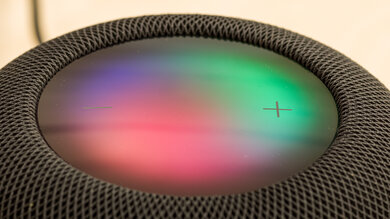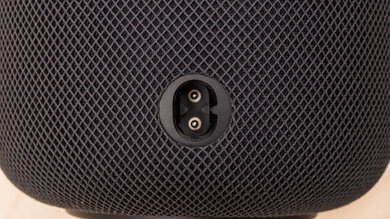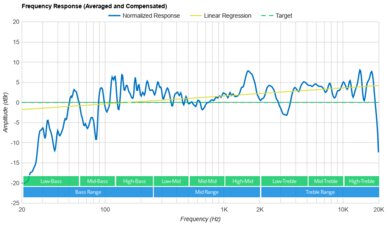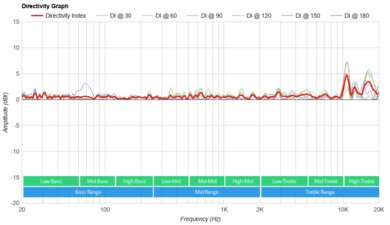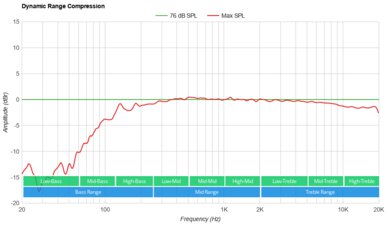The Apple HomePod (2nd generation) is a stylish home speaker with built-in Siri for hands-free control. It has a similar design to the original Apple HomePod (1st generation) with support for immersive Spatial Audio tracks found on certain streaming platforms. However, it adds some new features for an improved sound. For example, its bass-EQ microphone is designed to maintain a steady response in the lower frequencies, even when you listen at low volumes. This speaker is ideal for those who already own products in the manufacturer's ecosystem, but it doesn't offer sound customization tools like other smart speakers on the market.
Our Verdict
The Apple HomePod 2 is decent for music. Like most premium devices on the market, it has a room correction tool that automatically adjusts its output based on your room's unique acoustic characteristics. Voices and lead instruments are clear and present in the mix, and there's a touch of extra brightness in the treble. Also, this speaker can reproduce a more extended low bass than its predecessor, which is great for fans of bass-heavy music like EDM and hip-hop. That said, you can't customize its sound at all, and it has to downmix stereo content into mono, which is disappointing for such a premium speaker.
-
Room correction tool.
-
Extended low-bass.
-
No sound customization tools.
-
Downmixes stereo content into mono.
The Apple HomePod 2 is adequate for watching videos from your paired device. Dialogue is reproduced with clarity, and its extended low bass ensures you feel some rumble in more action-packed scenes. However, this speaker doesn't get as loud as other models on the market, so it can't bring a full cinematic sound. Plus, it has to downmix stereo sound into mono to play it back.
-
Extended low-bass.
-
Apple AirPlay compatibility.
-
No sound customization tools.
-
Downmixes stereo content into mono.
The Apple HomePod is fair for podcasts. Dialogue is reproduced with clarity right out of the box, meaning you can follow along with your favorite shows with ease. It gets loud enough to fill an average-sized room with sound, too. However, due to its wired design, you can't bring it with you to different rooms in the house, so you're limited to one spot when you listen. You'll need to buy multiple units if you want to spread sound to different rooms in your house using its multi-room function.
-
Room correction tool.
-
Apple AirPlay compatibility.
-
No sound customization tools.
-
Wired-only design.
This Apple HomePod is fantastic for voice assistant use. Built-in Siri lets you activate the device using only your voice, meaning you can enjoy hands-free control of your smart devices. The speaker easily understands your commands, too, even if you're further away or in a noisier environment. While there isn't a physical microphone mute button, you can ask Siri to stop listening when you want more privacy.
-
Room correction tool.
-
Built-in Siri.
-
No sound customization tools.
The Apple HomePod isn't meant for outdoor use. It's a wired-only speaker that has to be connected to an outlet to use.
- 7.2 Music
- 6.0 Videos/Movies
- 6.5 Podcasts
- 9.2 Voice Assistant
- 4.5 Outdoors
- Updated Feb 13, 2024: While there aren't any changes in the test results, we've updated the text for clarity and consistency across reviews.
- Updated May 08, 2023: Added comparison to the Bose Smart Soundbar 900 in the Frequency Response Accuracy box.
- Updated Apr 20, 2023: Added market comparison with the Sonos Era 100 in the App box.
- Updated Apr 03, 2023: We subjectively evaluated the performance of two Apple HomePods stereo paired together in the App box.
- Updated Mar 15, 2023: Following community feedback, we decided to perform additional testing to confirm that this is a mono speaker. You can learn more in theSoundstage box.
- Updated Feb 28, 2023: Review published.
- Updated Feb 23, 2023: Early access published.
- Updated Feb 21, 2023: Our testers have started testing this product.
- Updated Feb 15, 2023: The product has arrived in our lab, and our testers will start evaluating it soon.
- Updated Feb 02, 2023: We've purchased the product and are waiting for it to arrive in our lab.
Differences Between Sizes And Variants
The Apple HomePod is available in Midnight and White color variants. While we tested the Midnight variant, we expect the White variant to offer similar performance. You can see the label for the model we tested here.
However, if you encounter another version of this speaker, please let us know in the forums, and we'll update our review.
Compared To Other Speakers
This is the second generation of the Apple HomePod with a similar design to its predecessor. However, it can reproduce a more extended low bass, so it's better suited for listening to bass-centric music genres. However, compared to other smart speakers on the market, it doesn't offer a lot of sound customization tools. Plus, many of its features, like its companion app, are only available on iOS devices, so Android users can't access them.
You can also check out recommendations for the best home speakers, the best smart speakers, and the best Alexa speakers.
The Apple HomePod (2nd generation) is better than the Apple HomePod mini. The 2nd generation HomePod speaker is larger, so it can reproduce a lot more rumble in the low-bass, and it gets louder. Plus, it has a built-in room correction microphone to automatically optimize its audio based on your room's unique acoustics, which the mini lacks.
Depending on your listening habits, you may prefer either the Amazon Echo Gen 4 or the Apple HomePod (2nd generation). Both smart speakers offer excellent voice assistant support through their respective assistants. Only the Amazon speaker can playback stereo content without downmixing it to mono, and its bass and treble adjustments make it more customizable overall. That said, the Apple speaker brings more rumble in the low-bass, which is great for fans of EDM and hip-hop.
Depending on your listening habits, you may prefer either the Amazon Echo Studio or the Apple HomePod (2nd generation). These speakers are designed for integration with products that are in their respective ecosystems, like Amazon's Zigbee hub or Apple's AirPlay. Apple's Siri does a bit better at hearing your commands in noisy environments, and it brings more rumble in the low bass. However, the Amazon speaker is more customizable thanks to its companion app's bass and treble adjustments.
Depending on your listening habits, you may prefer either the Google Nest Audio or the Apple HomePod (2nd generation). Both smart speakers offer great voice assistant support through their respective assistants, though Apple's Siri does a bit better in noisier environments. The Apple has a more extended low-bass, which is great for listening to bass-centric music. However, it doesn't come with bass and treble adjustments like the Google speaker, so you can't customize its sound.
The Bose Home Speaker 500 and the Apple HomePod (2nd generation) are both wired smart speakers designed for home use. Only the Bose supports Bluetooth audio playback, and its bass and treble adjustments make it more customizable than the Apple. However, its low-bass isn't as extended as the Apple's, so you don't hear as much rumble in bass-heavy music. The Apple speaker is well-suited to users who already own products in their ecosystem.
The Apple HomePod (2nd generation) and the Sonos Era 100 are both very premium smart speakers, and depending on your listening habits, you may prefer one over the other. First, if you already own products in either the Apple or Sonos ecosystem, you'll find it's easier to integrate them with their respective speaker. For example, the Sonos speaker is designed to work with Sonos soundbars. Also, the Sonos is more customizable, with bass and treble adjustments on hand, and it supports Bluetooth, unlike the Apple speaker. However, the Apple can reproduce a better low-frequency extension, so you feel more thump and rumble in your audio.
The Sonos Era 300 and the Apple HomePod (2nd generation) are both wired home speakers that perform very similarly. They have slightly different strengths, so choosing between them will come down to personal preference and which one integrates into your existing home electronics ecosystem. Both speakers are decently well-built and have balanced sound profiles that employ room correction tools to harness the acoustic potential of your room. However, the Sonos can get slightly louder and has slightly better directivity. It also features both Wi-Fi and Bluetooth compatibility, whereas the Apple can only connect via Wi-Fi. The Apple boasts outstanding voice assistant compatibility, with built-in Siri capabilities and excellent voice command recognition. It also has more intuitive controls, although its app isn't quite as easy to use as the Sonos.
The Apple HomePod (2nd generation) is better than the Apple HomePod (1st generation). While both speakers have a similar design, the 2nd generation model can reproduce a more extended low-bass, so you hear more thump and rumble in the mix.
The Harman/Kardon Onyx Studio 8 and Apple HomePod (2nd generation) are both premium speakers that cater to different needs. The Harman/Kardon can be operated wirelessly and has better portability, making it a better choice for on-the-go listening. You can also use it to stream audio via Bluetooth, which isn't possible on the Apple. The Apple has a different feature set, with WiFi compatibility and excellent voice assistant integration. It's better suited to acting as a smart speaker hub to help integrate other smart devices. It also has iOS compatibility, so you can adjust a bevy of settings via your iOS device. Both speakers have similarly balanced default sound profiles, though, and feature room correction tools to bring out the best of your unique acoustic space.
Video
Test Results
This speaker isn't really designed with portability in mind. Rather, it's a wired home speaker that's meant to live mostly in one place in your home. Still, it's lightweight enough to transport from room to room with ease.
This Apple HomePod is made of good-quality materials overall. It sits on a plastic base with mesh fabric wrapping around its sides for a look and feel similar to its original model. The glass plate on top of the speaker gives it a premium touch. Plus, this version has a removable power cable, which is handy if you want to thread the cable through a hole in your desk.
On top of the speaker, there's a glass panel that you can use to control the device. You can adjust the volume or tap the buttons twice to skip to the next track or return to the previous track. You can also take calls on the HomePod and answer them by tapping on the top of the speaker. That said, the speaker is designed to be controlled with your voice, so you can command it using built-in Siri. If you want to mute the microphone, for example, you need to ask Siri to stop listening, as there isn't a physical control for this function.
This speaker has very good frequency response accuracy. Its room-sensing feature works like a room correction tool, using built-in microphones to analyze your room's unique acoustics and optimize its audio reproduction accordingly. It's always active, too. Overall, its sound is relatively even with a touch of extra brightness, making it suitable for listening to many different types of audio content.
While listening to the speaker subjectively, we found that the bass holds nicely, so you get a good round sound even at lower volumes. It's likely because of Apple's bass-EQ microphone, which they say is designed to dynamically tune lower frequencies in real-time. To test this feature, we ran a pink noise file at different volume levels, the results of which you can see here. The louder the volume, the less of a bass range difference we see in the graph. At higher volumes, the bass tends to align with the treble.
We've received some feedback from users interested in whether it would be worthwhile to pair two 2nd Gen HomePods or to purchase the premium Bose Smart Soundbar 900. Ultimately, we found that the Bose soundbar gets much louder, and its soundstage is cleaner and more defined. Meanwhile, the HomePods have a pleasant soundstage, though it isn't as precise, giving a slightly veiled feel. There's somewhat of a hole where the center channel would usually be located, too. That said, the HomePods bring an impressive amount of bass for their size, and their Siri capabilities are a definite advantage. Depending on your preferences, you may opt for one setup over another. Adding a sub to the Bose soundbar is also a good option if you want bass with that setup.
This speaker's soundstage performance is good. You get consistent sound from all angles around the speaker. On its own, it has to downmix stereo content into mono.
There's been some chatter in the community about whether the HomePod is truly a mono speaker. We compared it to a true stereo speaker—the Ultimate Ears MEGABLAST—to demonstrate why we categorize it this way. We started by playing a left-driver-only pink noise audio file, then connected a microphone to pick up the audio. As you can see in this video, there's about a 10 dB difference when we move the microphone from the left side of the speaker, which is playing sound, to the right side, which isn't. Then, we used our hands to cover and uncover each side of the speaker to confirm that all sound came from the left side. Finally, we repeated the same process on the HomePod. This time, there was only about a 1 dB difference between the left and right sides of the speaker. Even when we use our hands to cover one side of the speaker, audio is still heard without issue. Thus, it acts like a mono speaker.
That said, you can always stereo pair this speaker with another 2nd generation HomePod. Given community chatter, we decided to stereo pair two HomePods together and add them to an Apple TV 4k to get a sense of its performance. Subjectively, when listening to stereo content like music, the second speaker offers a clear separation between the left and right channels. Dialogue and other details are clearly reproduced in movies, too, though they're missing the rumble in the bass you'd get with a dedicated subwoofer. Similarly, there's a good sense of left and right separation with Dolby Atmos content. You get some elevation to the front and the sides, but the speakers don't bring a sense of action happening above and behind you like a true 5.1 setup.
This speaker gets loud enough to fill an average-sized living room with sound. However, it's unsuitable for listening in larger or more open spaces. While our graph shows some compression in the bass range at max volume, we suspect that this is due to the speaker's bass-EQ dynamic tuning, as, in actuality, you don't notice much compression in the mix.
Thanks to built-in Siri support, controlling this speaker using your voice is easy. You have multiple options for muting the microphone, too. You can either ask Siri to stop listening or turn this feature off in the companion app.
The Apple Home app lets you control the speaker from your phone or mobile device. Only available with iOS, it helps you manage other Apple speakers in your ecosystem for stereo pairing or spreading audio throughout multiple rooms in your home. Also, you can set alarms and timers, which is handy. However, there aren't any sound customization features on hand, like with the Sonos Era 100, which is disappointing.
Given the interest from the community, we decided to stereo pair two HomePod speakers and subjectively evaluate the sound. We also launched an Apple TV 4K and added the device to the same Room as both speakers in the Apple Home app. With stereo content such as music, we found speakers offer a balanced sound with a solid amount of bass. The soundstage is wide, and sound effects are accurately localized to the left and the right, as you would expect with stereo speakers. With movies and videos, dialogue and other details are reproduced with clarity. There's a good amount of bass, but not as much as you would find with a dedicated subwoofer. Similarly, Atmos content is clear and engaging but not as immersive as a 5.1 setup. There's a sense of elevation towards the front and the sides on some scenes, but no real sense of height over your head or behind you. You can also ask Siri questions while watching movies or listening to music, which is handy. Siri's only functional on one of the two speakers, though.
While the manufacturer advertises this speaker to support Bluetooth 5.0, you can't stream audio to the speaker over this connection. It's only really used in the initial setup process.
This Wi-Fi-compatible speaker makes streaming audio from the manufacturer's other devices easy over Apple AirPlay. Its AV sync error over this connection is a touch higher than that of the original Apple HomePod (1st generation). However, it still falls within good limits. You aren't likely to notice a delay between the audio you hear and the visuals on screen, which is ideal for watching videos.





